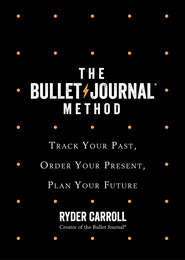
Полная версия:
The Bullet Journal Method
Before We Dive In . . .
Most of the organizational methods people tried to shove down my throat didn’t make sense, felt impractical, and left me feeling frustrated and/or demoralized. Those are the last things I want you to feel!
I’ve done my best to avoid making this part read like stereo instructions, but it’s unavoidably technical. At first glance, it may look like there are a lot of moving parts. As you read through the following chapters, I invite you to consider each component individually. Hold it up to the light; examine it. Ask yourself: Would this help me?
If at some point you feel overwhelmed, take a step back and start by implementing only the pieces that make sense. Most components are self-contained by design, so you can effectively use them even if you don’t use the rest. Start with what speaks to you—even if it’s just one piece—and build from there. This is also the way the Bullet Journal was born: one workable piece at a time.
KEY CONCEPTS
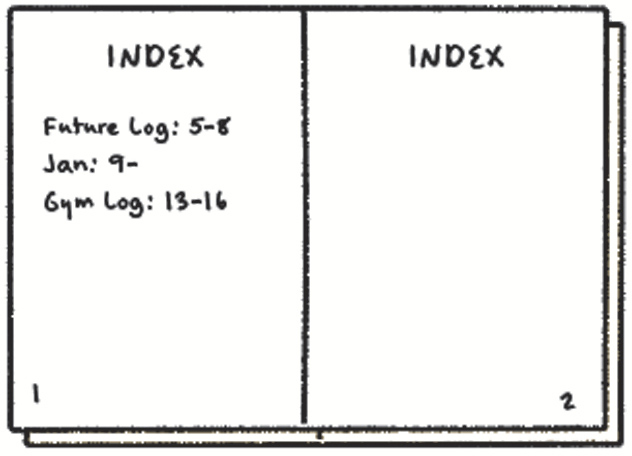
INDEX
Used to locate your content in your Bullet Journal using Topics and page numbers.
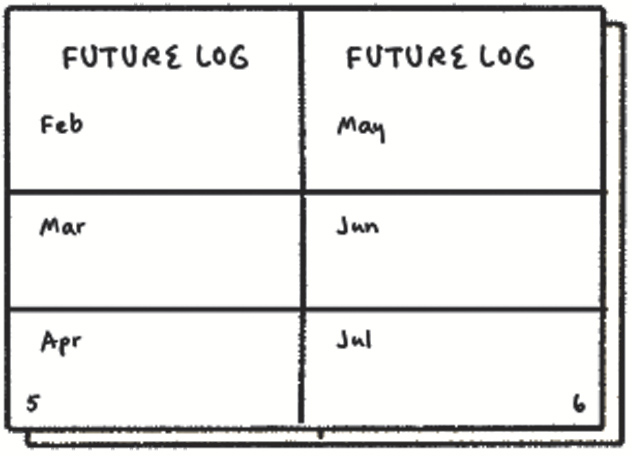
FUTURE LOG
Used to store Future Tasks and Events that fall outside the current month.
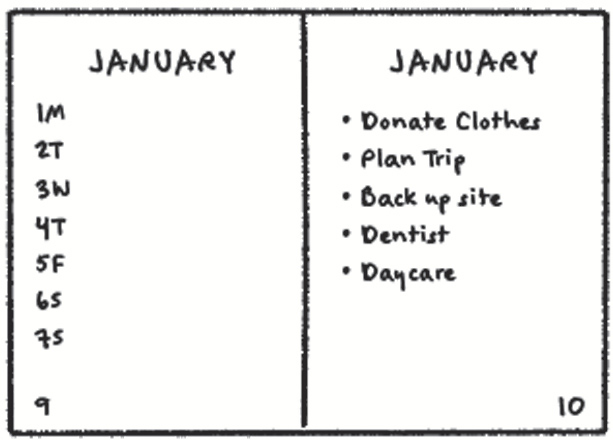
MONTHLY LOG
Provides an overview of time and tasks for the current month. Also functions as your monthly mental inventory.

DAILY LOG
Serves as your catchall for Rapid Logging your thoughts throughout each day
RAPID LOGGING
Using short-form notation paired with symbols to quickly capture, categorize, and prioritize your thoughts into Notes, Events, and Tasks.







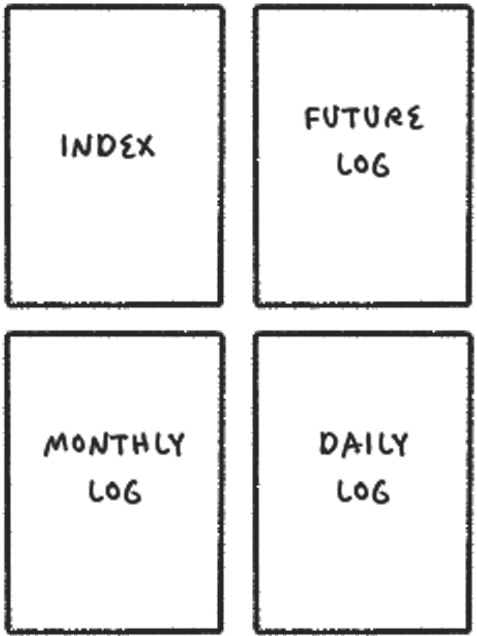
COLLECTIONS
The modular building blocks of BuJo, used to store related content. The core collections are the Index, Future Log, Monthly Log, and Daily Log, but you can create one for anything you want to keep track of.
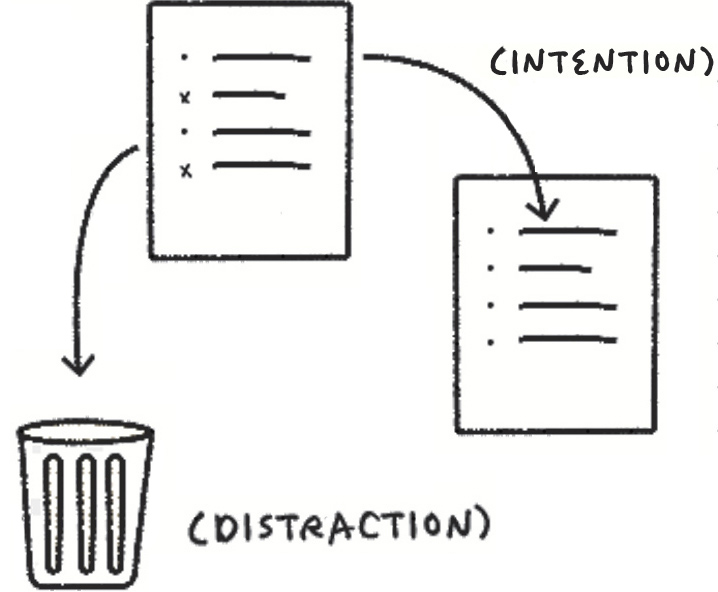
MIGRATION
The monthly process of filtering out meaningless content from your notebook.
RAPID LOGGING
Quick—what was the last meaningful thing someone said to you? Okay, let’s try an easier category: What did you eat for lunch two days ago? If you’re drawing a blank, you’re not alone. It goes to show that we can’t rely on memory to accurately capture our experience.
Our experiences—both sweet and sour—are lessons. We honor these lessons by writing them down so we can study them and see what they have to teach us. This is how we learn, this is how we grow. If we forfeit the opportunity to learn from our experiences, as the saying (sort of) goes, we condemn ourselves to repeat our mistakes.
Journaling provides a powerful way of facilitating this path of self-learning. The problem with traditional journaling is that it is loosely structured and time-intensive. Rapid Logging leverages the best aspects of journaling by stripping away everything that’s not essential. It’s the language the Bullet Journal is written in. In short, Rapid Logging helps us capture and organize our thoughts as living lists.
Rapid Logging will help you efficiently capture your life as it happens so that you may begin to study it.
On the following pages you’ll find visual examples illustrating the difference between content captured in a more traditional way and the same information organized with Rapid Logging. We’ll break down the symbols and structure in detail later, but it’s easy to see how succinct and clear the Rapid Log is. This streamlined approach to recording our thoughts saves a lot of time, allowing it to easily fit into our busy lives.
As Bullet Journalist Ray Cheshire describes: “I’m a high school science teacher at a big inner-city school in the UK. Things can get a little hectic at times as we try to cram ever more stuff into our days. This is where Rapid Logging comes in. For example, we were told that an inspection was going to happen at very short notice, but thanks to Bullet Journaling, I quickly knew what I still had to do before the inspectors arrived.”
Be it at home, school, or the workplace, Rapid Logging will help you organize the dizzying array of things you have to contend with on a daily basis.
TRADITIONAL
☑ Call Keith back to figure out where we should eat this weekend.
☐ Email Heather again regarding the Acme Co release forms for project participants. Need to send out the forms to them and have their signatures before we proceed.
The Acme Co UX presentation is due February 12.
☐ Email Leigh about her party that she’s having on April 21.
The office will be closed on the 13th.
I was happily surprised that Margaret seems to have taken her feedback to heart. She volunteered to help manage the assets for the project and has become a more engaged part of the team. Her work is also showing progress.
☐ Call to cancel yoga orientation.
☐ Order Kim a birthday cake for next week on Thursday. It has to be gluten-free because she is celiac.
☐ Add hours for Acme Co project to the time tracker.
Broadway was blocked on my way to work this morning, so I had to take a detour. On the way I spotted a new coffee shop I have to try. It’s also a lot more scenic a route. I put the windows down and just enjoyed the ride. I get so caught up in rushing to work that I totally forgot about this route. By the time I got to work, I was feeling pretty good even though I was a little late.
☐ Plan trip
225 words
RAPID LOGGING
04.01.TH











04.02.FR










89 words
(About 60% less!)
TOPICS AND PAGINATION
The first step in Rapid Logging is to frame the content you’re about to log. You do this by giving your page a Topic name. It can be as simple as “Shopping List.” Even here—as with most things BuJo—there is more than meets the eye. Topics actually serve three functions:
1 They identify and describe content.
2 They serve as an opportunity for you to clarify your intention.
3 They set the agenda for the content.
How many meetings have you sat through that have little to no agenda? Generally, they’re not very productive. Pausing to define the agenda before you start allows you to focus, prioritize, and use your time far more effectively.
Giving your page its Topic provides that opportunity to pause. What will you capture in this space? What’s its purpose? What value will it add to your life? These may seem like superfluous considerations, but I can’t tell you how many times I’ve sat down to make yet another list, only to realize that it simply wouldn’t add anything meaningful to my life. Does tracking the TV shows I’ve watched this year add any real value? No. I can reinvest that time I saved into something that does. Other times, that pause has helped me refine my aims, keeping the content of my Bullet Journal focused and relevant. Topic by Topic, pause by pause, we’re honing our ability to focus on what matters.
Often all it takes to live intentionally is to pause before you proceed.
Lastly, a good Topic turns your Bullet Journal into a more useful reference. Who knows when you may need to look back through your journal to find a specific Topic? “Oct 13, Meeting 4 notes” says little, whereas “10.13.TH (month/date/day) / Acme Co. (client name) / Website Relaunch (project name) / User Feedback (meeting priority)” provides you with a useful description.
Once you’ve defined your Topic, write it at the top of the page. Now you’ve laid the foundation for what you want to build, but you can’t locate a building without its address. That address in your Bullet Journal is the page number, so be sure to add them as you go. Page numbers will be critical when we get to Indexing (this page). Spoiler alert: Your Index helps you quickly locate your content.
The only time we don’t use a descriptive Topic is for our Daily Log (this page). It’s a catchall for our thoughts, so the daily Topic is simply the date, formatted as month/date/day. This will help you quickly orient yourself when flipping through your pages.
All this is more complicated to explain than it is to do. In practice, you’re just taking a few seconds to think before putting pen to paper. Now, with the Topic and page number in place, your page is prepared to handle anything you throw at it.
04.01.TH











04.02.FR










Don’t forget to number your pages!
BULLETS
If Rapid Logging is the language the Bullet Journal is written in, Bullets are the syntax. Once you’ve set up your Topic and page number, you capture your thoughts as short, objective sentences known as Bullets. Each Bullet is paired with a specific symbol to categorize your entry. We use Bullets not only because it takes less time, but also because wrestling information into short sentences forces us to distill what’s most valuable.
Crafting effective Bullets requires striking a balance between brevity and clarity. If an entry is too short, we may not be able to decipher it later. If it’s too long, then writing down your thoughts becomes a chore. For example, “Return call ASAP!” is too short. Who are you calling back? What are you calling them back about? It’s easy to forget all that in the rush of the day. Conversely, “Call John M. back as soon as you can because he needs to know when you will have the sales figures for June ready for him” is an overly informative word salad. Let’s try again: “Call John M, re: June sales figures.” You’re saying exactly the same thing using only a quarter of the words. In a bit, I’ll also show you how to turn that Task into a priority using Signifiers (this page).
Keeping your entries short without losing meaning takes practice, but over time it hones our ability to identify what’s worth writing down. That’s important because our lives are infinitely complex, and there is potentially a lot to keep track of. If you’ve kept lists in the past, you’re familiar with how quickly they can spiral out of control. They often lack context and priority. Rapid Logging solves this issue in a few ways, first by categorizing entries into:
1 Things that you need to do (Tasks)
2 Your experiences (Events)
3 Information you don’t want to forget (Notes)
Each category is assigned a symbol to upgrade a basic list with much-needed additional layers of context and function. During the day, these symbols allow you to quickly capture and contextualize your thoughts in real time. Later on, they make locating specific content much easier as you scan through your pages. Let’s take a look at each category and see how this syntax can keep your entries organized, lean, and effective.
TASKS
The Task bullet does a lot of heavy lifting. Think of it as a checkbox. (Older versions of the Bullet Journal used an actual checkbox, but eventually it became clear that checkboxes weren’t as efficient as the dot Bullet: They take more time to draw and can look sloppy, decreasing legibility.) The Task “


Entries that require you to take action.

Action has been completed.

Tasks that have been moved forward (hence the right arrow) into your next Monthly Log (this page) or into a specific Collection (this page).

A Task tied to a date that falls outside of the current month and is therefore moved backward (hence the left arrow) into the Future Log (this page) at the front of your book.

Sometimes the things we task ourselves with end up not mattering anymore. Their meaning simply expires or circumstances change. If it no longer matters, then it’s a distraction. Strike it off your list. One less thing to worry about.
Subtasks and Master Tasks
Some Tasks require multiple steps to complete. These dependencies—or Subtasks—can be listed by simply indenting them directly below their Master Task. Master Tasks can only be marked as complete once all of the Subtasks have also been completed or marked as irrelevant.
TIP: When you notice a Master Task spawning a lot of Subtasks, it can indicate that this Task is growing into a project. If that’s the case, you may want to turn this nested list into its own Collection (this page). Planning a trip, for example, can be complex, with Tasks ranging from researching locations to arranging transportation—each of which might have Subtasks (check out X, Y, and Z hotels online; price flights and rent a car). If you notice that a Task is turning into a project, but you don’t have time at that moment to set up a new Collection, just log a Task to remind you to set one up later: “

04.01.TH


Конец ознакомительного фрагмента.
Текст предоставлен ООО «ЛитРес».
Прочитайте эту книгу целиком, купив полную легальную версию на ЛитРес.
Безопасно оплатить книгу можно банковской картой Visa, MasterCard, Maestro, со счета мобильного телефона, с платежного терминала, в салоне МТС или Связной, через PayPal, WebMoney, Яндекс.Деньги, QIWI Кошелек, бонусными картами или другим удобным Вам способом.
Вы ознакомились с фрагментом книги.
Для бесплатного чтения открыта только часть текста.
Приобретайте полный текст книги у нашего партнера:
Полная версия книги
Всего 10 форматов



